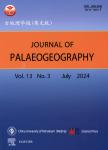Paleosols of the upper Paleozoic Sangre de Cristo Formation,north-central New Mexico:Record of early Permian palaeoclimate in tropical Pangaea
Paleosols of the upper Paleozoic Sangre de Cristo Formation,north-central New Mexico:Record of early Permian palaeoclimate in tropical Pangaea作者机构:Department of Biological SciencesLe Moyne CollegeSyracuseNY 13214USA New Mexico Museum of Natural History1801 Mountain Road N.W.AlbuquerqueNM 87014USA
出 版 物:《Journal of Palaeogeography》 (古地理学报(英文版))
年 卷 期:2017年第6卷第2期
页 面:144-161页
核心收录:
学科分类:0303[法学-社会学] 0710[理学-生物学] 070903[理学-古生物学与地层学(含:古人类学)] 0709[理学-地质学] 07[理学] 0708[理学-地球物理学] 0705[理学-地理学] 0815[工学-水利工程] 0813[工学-建筑学] 0833[工学-城乡规划学]
主 题:Sangre de Cristo Formation Wolfcampian Vertisol Argillisol Calcisol Protosol
摘 要:The lower Permian(Wolfcampian) Sangre de Cristo Formation of northern New Mexico consists of silty mudstones and laterally discontinuous sandstones deposited on an aggrading alluvial plain.Locally,mudstones display a variety of pedogenic features.Common mudstone fabrics vary from platy to prismatic;some beds display prominent pedogenic slickensides.Drab-colored root traces are common throughout the section,as are calcareous nodules,which vary from small bodies with diffuse boundaries to vertically stacked,discrete,cm-scale nodules(rhizocretions),and less commonly form coalescing horizons.Vertisols occur only in the lower portion of the ca.90-m measured section.Most of the mudstone beds contain calcretes that are immature(calcic Protosols to calcic Argillisols),but the lower to middle portion of the section also contains mature calcrete horizons(argillic Calcisols and Calcisols).Intercalated micritic limestone beds with sharp contacts containing root traces,are of laterally variable thickness and grade to nodular calcretes.These are interpreted as floodplain pond carbonates that have undergone pedogenic alteration(palustrine limestones),indicating long periods of exposure under strongly seasonal climatic conditions.The isotopic composition of the pedogenic carbonate displays a substantial range of values,but most of the range of variation in isotopic composition is accounted for by isotopically heavier carbonate(both carbon and oxygen) precipitated in shallow ponds subject to intense pedogenic reworking(palustrine carbonate).During the early Permian,northern New Mexico was situated in a near equatorial position(ca.4° N).The overall character of the paleosols suggests a persistent warm,semi-humid,seasonal climate throughout most of the interval of deposition during the Wolfcampian,but with episodically increased aridity during formation of the more mature calcretes.No long-term trend of climate change is evident in the stratigraphic section examined for this study.



